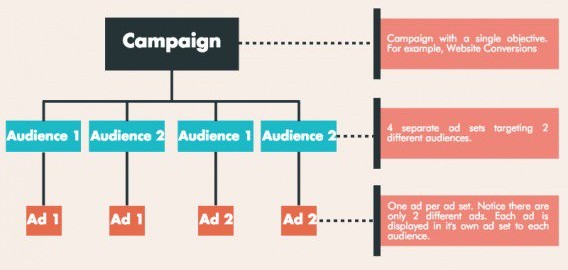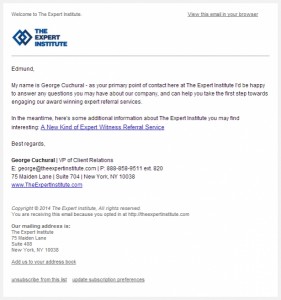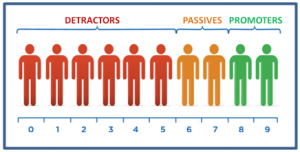Having a well-thought-out plan for A/B testing Facebook ad campaigns is essential if you want to improve your performance reliably and consistently.
And the more you test, the better. A study of 37,259 Facebook ads found that “most companies only have 1 ad, but the best had 100’s”.
A/B testing Facebook ad campaigns can get complicated quickly (and easily produce invalid results). Spending the time upfront to perfect your testing process / structure will go a long way.
The Structure of a Facebook Ad Campaign
To develop a solid testing plan, it’s important to understand the structure of a Facebook ad campaign. The image below shows the 3 ‘levels’ of a campaign and describes the purpose of each one.

1. Campaign
The campaign is the overarching container that defines the objective of your Facebook ads.
For example, if you want to bring people from Facebook to your website and convert them to subscribers or customers, you would choose the objective ‘Website Conversions’.
For the purpose of A/B testing, my preference is to limit the scope of testing to a single campaign. Running A/B testing across multiple campaigns isn’t a necessity and makes it more difficult to analyze the data.
2. Ad Set
An ad set defines a particular target audience. It is also used to define your budget, schedule and bid type.
A campaign can contain multiple ad sets and each ad set can target a different audience, but it may also target the same one. Most campaigns will contain multiple ad sets targeting multiple audiences.
3. Ad
The ad is the creative that people see on Facebook or Instagram. It’s possible for each ad set to contain multiple ads.
There are several components to a Facebook ad: the image or video, the headline, the body text, and a link description.
Creating an Organized Testing Process
To optimize your campaigns effectively, you will need to test multiple ad sets (target audiences) and multiple ads for each ad set. This can get very messy very quickly without a plan and without understanding a few best practices.
There is no 100% correct way to do this… everyone has a different method. This is my preferred method based on data and my own past experience.
Your Testing Options Are Exponential
First, let’s look at the numbers. If you break down all of the different possible combinations for testing, the number of possible tests is quite daunting.
For example, let’s say you have 5 different target audiences to test running ads against.
And for your ad creatives, you have: 5 different ad images, 5 different ad headlines, and 5 different blocks of ad text.
That gives you 5 x 5 x 5 = 125 different possible ad creatives to test across your 5 target audiences, which means you have a total of 625 possible combinations to test.
That’s not to mention if you split your target audiences up by demographic details such as gender, age range and location.
Taking the same example and splitting our 5 target audiences up into…
- Male and female.
- Ages 18-25 and ages 26-32.
- Australian and American.
…takes the total possible combinations to 5,000 (40 ad sets x 125 ads).

Start Broad, Narrow Down Based on Data
To make the process manageable, you need to simplify things and limit the number of A/B tests you choose to run at any given time.
You can do this by starting with a broad audience and a narrow selection of ad creatives. You then use the wealth of data that Facebook provides in its ad reporting to further refine your A/B tests over time.
Facebook actually provides a breakdown of your ad performance based on location, age, gender, ad placement and more. You can use this data to simplify the testing process.
Here is how this looks when applied in a practical situation.
You would create a new ad set and target an audience based on a particular ‘interest’ on Facebook. Rather than only selecting a single gender or a narrow age bracket, you would leave these set to “All” and “18 to 65+”.

Because the Facebook reporting tool will tell you which gender and age bracket converted best for this ad set, you can analyze that data and exclude the underperforming demographics in your next test.
 Molly Pittman, Digital Marketer:
Molly Pittman, Digital Marketer:
“In terms of Age (and Gender), a big misconception a lot of people have is that they MUST define their audience by these parameters.
Most of the time, if you do this, you’ll actually hurt your campaigns by making the assumption of the age/gender of your audience.
For example, our sister company Survival Life thought their target market was older, white males, and that’s who they were targeting on Facebook. But one time, on accident, they forgot to select males as the target (so they were targeting both men and women).
Do you know what they found?
Their best converting ads in that campaign were from women — the more you know…
That’s why, whenever we set up ad campaigns in new markets, we leave the Age and Gender options totally open and…
….let the data and the results tell us the age and the gender of the people who are actually going to convert.” (via Digital Marketer)
Prioritizing Your A/B Tests
Now let’s talk about what to test first.
AdEspresso studied data from millions of dollars spent on Facebook ad A/B tests and listed the elements that provided the biggest gains.
Here are the 4 things they found mattered most when it came to ad targeting:
- Country
- Gender
- Interests
- Age
As you can see, interest targeting came in third, behind country and gender. But because it has such a big impact on the success of a campaign, interest targeting is the first thing I focus on when A/B testing.
As mentioned above, gender and age are best left set to ‘all’ so we can use the report data to determine which performs best later.
How to A/B Test Interests
When testing ad targeting options, you should only select one interest or behavior per ad set unless you are using the “Exclude People” or “Narrow Audience” options.
Why?
In the image above, you’ll notice above “detailed targeting”, it says: “INCLUDE people who match at least ONE of the following”. That means if you select multiple interests or behaviors, a person only has to match one of them to be targeted by your ad set.
However, the Facebook ad reports can’t be broken down by interest or behavior. That means if you include more than one interest or behavior in your ad set, you will be unable to measure their performance individually.
One of your selections may be performing really well, while the other performs poorly. You’ll see a mediocre ad set, but will never know that you had actually found a high performing interest or behavior.
Use Separate Ad Sets
To test different interests or behaviors, I recommend using a separate ad set for each one. This allows you to see exactly which one is performing best with the ad creatives you are using.
Mike Murphy, Business Coach at HeroTheory.com, had this to say on the topic:
 Mike Murphy, HeroTheory.com:
Mike Murphy, HeroTheory.com:
“Many folks will take their research from step one, gather their interests and then lump them all into one big list on the Facebook Ads Manager in hopes of reaching a large target audience. This is a grave mistake that will cost you far more in ad spend. And while you might get results, you’ll have no idea which interest brought the best results.
The solution: Include one interest per ad set so you can look out for the interests that bring the best results at the lowest cost.” (via Entrepreneur)
How to A/B Test Ad Creatives
We’ve covered audience targeting. Now let’s take a look at how you can test your ad creatives.
Before we move on, it’s important to note the way Facebook treats multiple ads in a single ad set because it affects the way we conduct A/B testing.
Having multiple ads in an ad set means that Facebook will automatically A/B test both of those ads and determine a winner using its own algorithm. Once Facebook determines a winner, it automatically scales back the number of impressions delivered to the losing ad.
However, this can be problematic because often a winner will automatically be determined based on a very small sample size…
 Kim Garst, Boom! Social:
Kim Garst, Boom! Social:
“One of the biggest challenges with split testing Facebook ads is that Facebook determines very early on in your advertising which of your ads is performing the best.
This usually isn’t an issue, however it can make testing multiple ads at the same time somewhat ineffective; this is because Facebook will often give the lion’s share of impressions to your best performing ad (at least in terms of clicks), and stop showing your lower-performing ads.” (via Kim Garst’s Blog)
Example: Facebook Calls It… Incorrectly
In the example below, you can see just how early Facebook makes a decision on which ad is performing best.
After only showing the ad to 722 people, Facebook had already scaled back impressions for ad variation 2, only showing it to 334 people (compared to 680 people for ad variation 1). You’ll also notice the disparity in budget allocation between the different ads, with Facebook spending $ 7.27 on one ad and only $ 1.58 on the other.
But what’s most interesting is the cost per website click (the goal of this campaign). The ad that was deemed the loser by Facebook was actually delivering cheaper results.

In order to get enough eyeballs on each of your ads and collect enough data to allow you to make intelligent decisions about your A/B tests, I recommend separating them into different ad sets.
Use Separate Ad Sets (…Again)
Instead of having a single ad set for a single target audience, I suggest having 2 separate ad sets targeting the same audience with a single, different ad in each. You can then let each ad run until you are satisfied with the amount of data available to you.
Once you make a decision on which ad is the winner, you can switch the underperforming ad set off.
Targeting the same audience with multiple ad sets can increase your costs due to the ad sets competing against each other in the bidding process, but this is minimal. It is also temporary because you will eventually turn off the ad sets that aren’t top performers.
Here is an example of what your campaign structure might look like with 1 ad per ad set:

What Exactly to Test
If we look back at the study from AdEspresso, it showed that when it comes to your ad creatives, these elements provided the biggest gains:
- Image
- Post Text
- Placement (e.g. News Feed, right column, mobile)
- Landing Page
- Headline
Based on that data, my preference is to focus on testing at least 3 different images and then 1-2 different sets of ad text.
This reduces the number of individual ads that are being A/B tested across different audiences at any one time, which simplifies the process. Once a winning audience and image combination is found, results can be incrementally improved by making changes to the elements that provide smaller gains, such as the post text and headline.
Obviously, the number of ad creatives you test depends on your overall budget, and capacity to create and analyze A/B tests. Larger budgets and more resources make it possible to test many more ad creatives at once.
How Much Does It Cost to Advertise on Facebook?
One of the benefits of Facebook ads is that you can start with a budget of as little as $ 1/day.
Costs are extremely conditional, but to give you a general idea of what you can get for your ad spend, let’s take a look at some stats from Nanigans’ Q4 2015 Global Facebook Advertising Benchmark Report.
- For Q4 2015, the global average cost per click (CPC) was $ 0.57.
- For the same quarter, the global average cost per 1,000 impressions (CPM) was $ 6.38.


Choosing the Right Metric
I recommend always focusing on the metric that’s most important to you instead of focusing on ‘fringe metrics’ like CPM. The reason I call it a fringe metric is because it feeds into primary metrics like cost per conversion (CPC).
If your goal is website clicks, focus on CPC instead of CPM.
If your goal is on-site conversions, focus on revenue instead of CPC or CPM.
Choosing one primary metric gives you a single measure of performance to use as a basis for your A/B testing.
When to Pick a “Winner”
As an absolute minimum, you should let your ads run for at least 24 hours before making any judgements about their performance. This gives Facebook’s algorithm enough time to optimize properly.
This advice comes directly from Facebook:
It takes our ad delivery system 24 hours to adjust the performance level for your ad. It can take longer when you edit your ad frequently. To fix it, let your ad run for at least 24 hours before you edit it again.
That’s not to say you should judge the performance of all of your ads after 24 hours.
This is the absolute minimum required to allow Facebook’s algorithm to optimize. Because the algorithm only becomes optimized after 24 hours, I like to let my ads run for at least 48-72 hours.
You will also need to ensure that you have enough data for your results to be statistically significant and valid. You can use this great calculator to help determine when your test achieves significance.
The amount of time it takes to collect enough data varies. It’s possible to deliver tens of thousands of impressions and get hundreds of results in a matter of days, but that requires a relatively large budget. (Based on the average CPM figures we saw earlier, 20,000 impressions would cost $ 127,000.)
A smaller budget means few impressions and results over the same period of time, so it takes longer to get a statistically significant result. Be sure you also account for the risk of sample pollution.
Whatever your budget, always test variations to significance before determining the winner and moving on to the next test.
Conclusion
My recommended approach for both audience testing and ad creatives testing is to A/B test the elements that stand to provide the biggest gains first. For audience testing, that’s interests and for ad creatives, that’s images.
Only then should you start conducting further A/B tests on elements that are less likely to result in large performance improvements.
This simplifies the process and allows you to achieve the biggest gains in performance early on.
The most important things to remember are:
- The more you test, the better. That goes for target audiences and ads.
- Conduct your tests in a tightly controlled manner so you can accurately determine which changes are responsible for changes in performance.
- Only target one interest per ad set so you can see which interest performs best.
- For the most accurate results, only have one ad in each ad set.
- Use the data in the Facebook ad reports to further refine your ad campaigns.
(154)
Report Post







